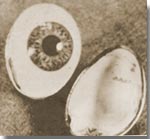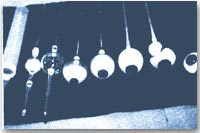A Brief History of Ocular Prostheses
The art of making artificial eyes has been practiced since ancient times. Egyptian priests made the first ocular prostheses, called Ectblepharons, as early as the fifth century BC. In those days, artificial eyes were made of enameled metal or painted clay and attached to cloth and worn outside the socket.
The first in-socket artificial eyes made in the 15th century were made of gold with colored enamel. In the latter part of the sixteenth century, the Venetian glass artisans discovered a formula that could be tolerated inside the eye socket. These early glass eyes were crude, uncomfortable to wear, and very fragile. Even so, the Venetian method was considered the finest in the world. They kept their methods and materials secret until the end of the eighteenth century.


In the 17th century the center for artificial eye making shifted to Paris for a time. Improvements in techniques and materials followed. The French word oculariste was given to the makers of artificial eyes. In the mid-nineteenth century, glass artisans in Thuringia, a region in eastern Germany, developed a superior glass formula for the making of artificial eyes. Combined with their techniques of blowing hollow glass objects, the center for glass eye making moved to Germany. The methods of making hollow kryolite glass prosthesis are still used today in Germany and many parts of the world. Glass eye making was introduced in the United States in the mid 1800’s by immigrant German ocularists. Although the American Ocularists of this era continued to make glass prostheses, the kryolite glass material itself was exported from Germany. Ocularists have been professionally trained in art and sculpting techniques to create the most life like appearance. Our custom ocular prostheses are individually designed using FDA approved materials and methods. The
The onset of World War II cut of the export of kryolite glass to the United States. With so many injured soldiers needing artificial eyes, the U. S. government searched for a replacement material. Almost immediately the new plastics industry came to the rescue. Medical plastics were already being used in the dental field before World War II. The Department of the Navy set up a crash course in applying plastics to the field of Ocularistry that lead to the development of medical grade acrylic plastic and its use in eye-making. Combined with the use of impressions in the design of the artificial eye, modern prostheses can be perfectly fit for each individual patient. The popularity of these methods has continued to increase over the years. Today the vast majority of patients all around the world wear ocular prostheses made of acrylic.

